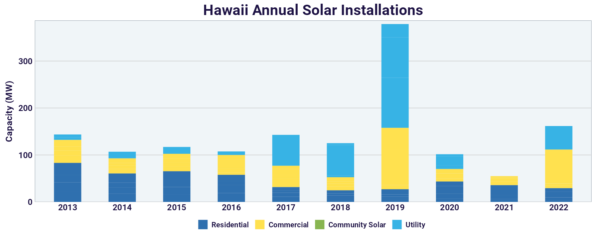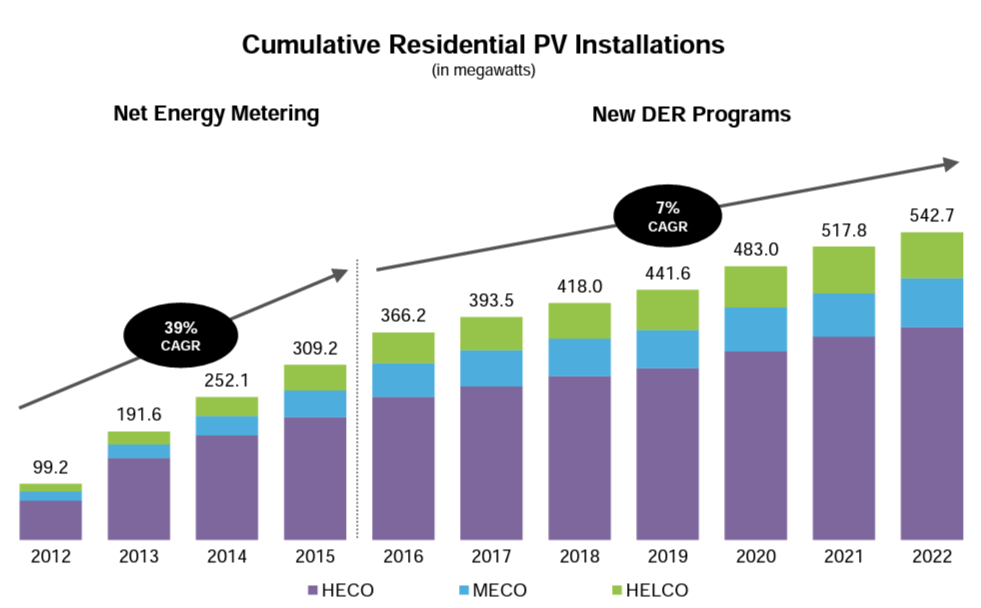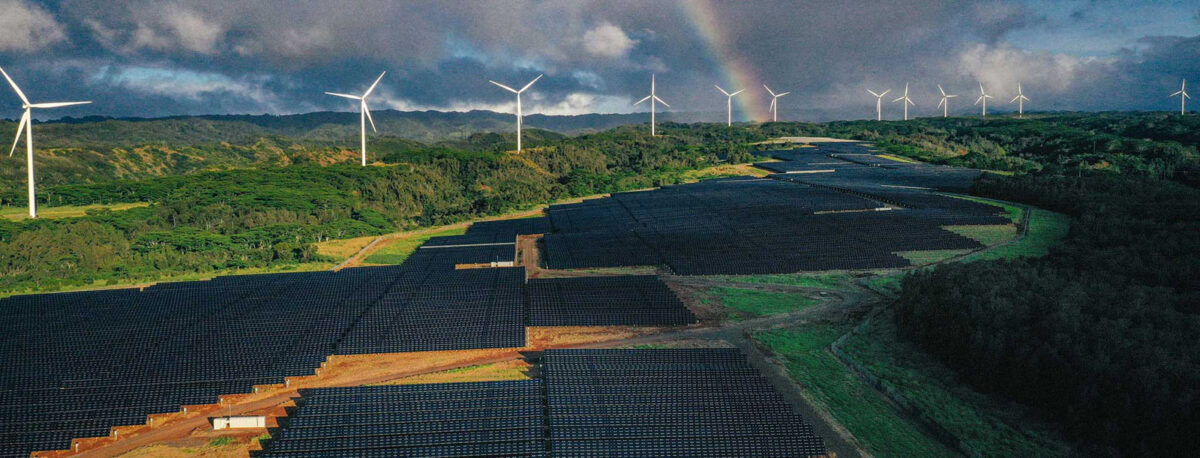Hawaii is the eighth smallest state by land area, but with 1.4 million residents, it ranks 13th in the country by population density. The 50th U.S. state has just 10,931 square miles of land mass, with sloped volcano ridges not ideal for sprawling utility solar development. However, Hawaii, or the Aloha State, has embraced the small-scale adoption of community solar, and in the 10 months since the Inflation Reduction Act has passed, the lush island state shows huge potential for new community projects.
Hawaii has the highest electric rate in the United States with the average price of 44.24 cents/kWh in early 2023, according to the Energy Information Administration. For the past century, Hawaii has relied on expensive imports of motor fuel, distillates, jet fuel and various other petroleum products for its power generation. But in 2018, the island state became the first in the U.S. to set a carbon neutral goal of becoming fully renewable powered by 2045.
With 1.72 GW of installed solar, Hawaii catapulted to 17th in the U.S. for solar generation from 27th in 2022, with 162 MW brought online for the year, according to the Solar Energy Industries Association (SEIA).

Solar represents 17.25% of the island state’s power mix and the state has made strides to deploy about 150 MW per year in new installations. At year end 2022, utility Hawaiian Electric (HECO) had achieved 32% of its renewable procurement standard goal of becoming fully renewable powered by 2045.
In 2022, the utility ended the use of coal plants, allowing the expiration of a last remaining power plant, while the state’s regulators committed to add 1 GW of new renewable energy projects, including 50,000 rooftop solar projects across the islands and expanding geothermal power development.
Incentives
Prior to 2015, Hawaii had a net metering framework but it lapsed in the regulator’s hands despite 60,000 residents signing up. In its place the state now has two distributed generation tariffs: the Customer Grid Supply Plus (CGS Plus) and the Smart Export tariff. The CGS Plus is available for residential and commercial customers, and Smart Export is for customers who own renewable energy plus energy storage systems.
HECO customers under the CGS Plus program receive a monthly bill credit for energy delivered to the grid based on an island-specific rate. The export credit rate was fixed through October 2022, with the islands of Hawaii (10.55 cents/kWh), Oahu (10.08 cents/kWh) and Maui (12.17 cents/kWh) seeing the lowest rates of the islands, while the lesser-populated Molokai (16.77 cents/kWh) and Lanai (20.80/kWh) enjoy the highest export rates to the utility, according to HECO’s website.
For solar-plus-storage users, ratepayers under the Smart Export framework receive an export credit of 11 to 20.79 cents/kWh depending on the island, while no export credit is available during daily peak times from 9 a.m. to 4 p.m., as this is the time ratepayers are to charge their home battery systems.
Like all solar installations in the U.S., Hawaiian solar projects are eligible for the federal Investment Tax Credit. The credit covers 30% of installed system costs, and can be rolled over year to year if the customer lacks the tax liability to take advantage of the credit in one tax year.

At year end 2022, HECO ratepayers contributed 542.7 MW of solar and storage power resources into the Hawaiian grid, as the investor-owned utility saw residents contribute to a sustained compounded annual growth rate from rooftop solar of 7% per year since 2016, the first year under the state’s current tariff framework.
Community solar
Building on the successes of its rooftop solar penetration rate, Act 100 of the Hawaii State Legislature was initiated in 2015 allowing for community solar. The Hawaii Public Utilities Commission (PUC) established a “community-based renewable energy” tariff, Sec. 269-27.4. The details of the tariffs and programs have been and continue to be developed under PUC docket #2015-0389.
Even though Hawaiian Electric refers to community solar as a “shared solar” program across its jurisdiction, the state’s utility allows community members to participate in local solar generation projects in nearby solar fields or rooftops without preclusions.
The inaugural phase of HECO’s community based renewable energy (CBRE) program has seen just shy of 6.02 MW of community solar projects enter operations or advanced-stage construction.
In November 2022, HECO selected its first seven community solar projects on the islands of Oahu, Hawaii and Maui, providing 27 MW of clean power to low- and moderate-income subscribers, as part of Phase 2 of the utility’s CBRE program.
Boston-based project developer Nexamp is currently completing the approval steps for the projects, and other projects across the island state, with a goal of commercial operations in 2025. The developer is building projects on the Hawaii (9 MW / 36 MWh storage), Maui (8 MW / 32 MWh storage) and Oahu (6 MW solar) islands. On Oahu, home of capitol city Honolulu, the developer partnered with MeLink Solar to develop that project.
Our commitment to accessibility shapes everything we do, Chris Clark, chief development officer of Nexamp, tells pv magazine USA, so we are proud to be bringing our expertise to Hawaii and addressing the needs of these communities. Dedicated to low- and moderate-income residents, each of these shared solar projects will ensure equal access and lower electricity costs for participants while reducing the state’s fossil fuel dependence as it works toward 100% renewable energy by 2045. This work will help to ensure that Hawaii, with its unique ecology and island geography, builds a clean and sustainable future for the next generation.
Other CBRE developments are going on across the isles.
The Kauai Island Utility Cooperative (KIUC), the utility that manages the grid on the western Kauai Island, does not have any community projects under development, according to the state’s CBRE website.
Further information as well as CBRE enrollment details can be found on the state’s interactive energy project directory.
Notable project
Located north of the village of Haleiwa on Oahu, Kawailoa Solar is a 49 MW utility solar project developed by Clearway Energy Group in 2019. The project produces enough electricity to power 16,808 homes and ranks as the largest Hawaiian solar facilities.
Kawailoa Solar was built on 300 acres of land owned by the Kamehameha Schools within the Kawailoa Plantation, a historic sugar cane plantation that also features a 69 MW wind farm built in 2018 by First Wind. Kawailoa Solar shares existing roads, substation, and transmission lines with the wind project.
The $7 million capital cost solar project was constructed by local construction subcontractor Goodfellow Brothers for developer Clearway Energy, using close to 500,000 solar panels.
Since becoming operational, Clearway Energy has utilized local ranchers to allow them to graze sheep for vegetation management on the Kawailoa site.
Aloha readers. This is the last and final stop off on the pv magazine USA tour of 50 states of solar incentives. The team last stopped in Alaska and our first stop on the tour was the great state of Maine in February 2022. Click here for the full 50 states of solar incentives.
This content is protected by copyright and may not be reused. If you want to cooperate with us and would like to reuse some of our content, please contact: editors@pv-magazine.com.









By submitting this form you agree to pv magazine using your data for the purposes of publishing your comment.
Your personal data will only be disclosed or otherwise transmitted to third parties for the purposes of spam filtering or if this is necessary for technical maintenance of the website. Any other transfer to third parties will not take place unless this is justified on the basis of applicable data protection regulations or if pv magazine is legally obliged to do so.
You may revoke this consent at any time with effect for the future, in which case your personal data will be deleted immediately. Otherwise, your data will be deleted if pv magazine has processed your request or the purpose of data storage is fulfilled.
Further information on data privacy can be found in our Data Protection Policy.